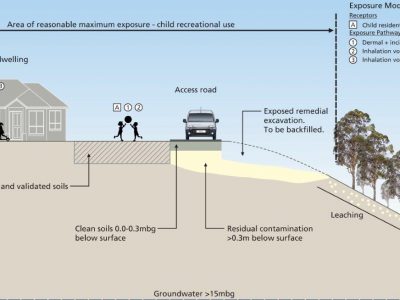Project Info
Project Description
Project: Remediation and Risk Assessment of TCE-Contaminated Groundwater at a Former Manufacturing Site
Situation: At a site previously used for rubber manufacturing, significant contamination of trichloroethylene (TCE) was discovered across three distinct water-bearing zones: shallow soil, the soil/bedrock interface, and a fractured rock system. This site, intended for future retail development, was classified as significantly contaminated by the NSW EPA under the Contaminated Land Management Act 1997.
Our Approach:
Geo-Logix led the development of a voluntary management plan aimed at both remediating the site and assessing the risks associated with the potential offsite migration of contaminants. The remediation strategy centered on encapsulating TCE-contaminated soil within ventilated, vapor-proof, and waterproof bags, which were strategically placed beneath the planned retail carpark.
Over five years, we conducted comprehensive risk assessments, including investigating vapor intrusion beneath nearby residential properties and performing detailed vertical and horizontal assessments of TCE contamination within the groundwater.
Key Discoveries:
Understanding the structural geology was crucial to our success. We conducted detailed rock core logging, downhole geophysics, and packer tests to accurately map the fracture network. Geological mapping extended to a local creek, 900 meters from the site, identified as a likely discharge point for groundwater. During these investigations, we discovered a fault that appeared to influence the northward migration of the groundwater plume. Notably, TCE was not detected on the opposite side of this fault, suggesting it redirected the plume towards the creek.
Following the fault trace to the creek, we found a spring in the creek gorge, where water samples confirmed the presence of TCE. Isotope analysis traced the contamination back to the site, while geochemical and microbial investigations revealed that the TCE was not degrading.
Outcome:
Over eight quarters, we monitored TCE levels in groundwater, spring water, and creek water. The results indicated that the contaminant plume had stabilized and was not worsening over time. An ecological risk assessment conducted by Terravale Consulting concluded that TCE levels in the spring and creek did not pose a threat to sensitive ecological species.
Ultimately, the findings indicated that health and environmental risks were low and manageable. Due to the successful remediation efforts and the age of the TCE release, the site was deemed suitable for commercial development and was subsequently removed from the Contaminated Sites Register.
This case highlights how robust scientific methods and strategic planning can effectively manage environmental risks, eliminating the need for costly groundwater remediation.





